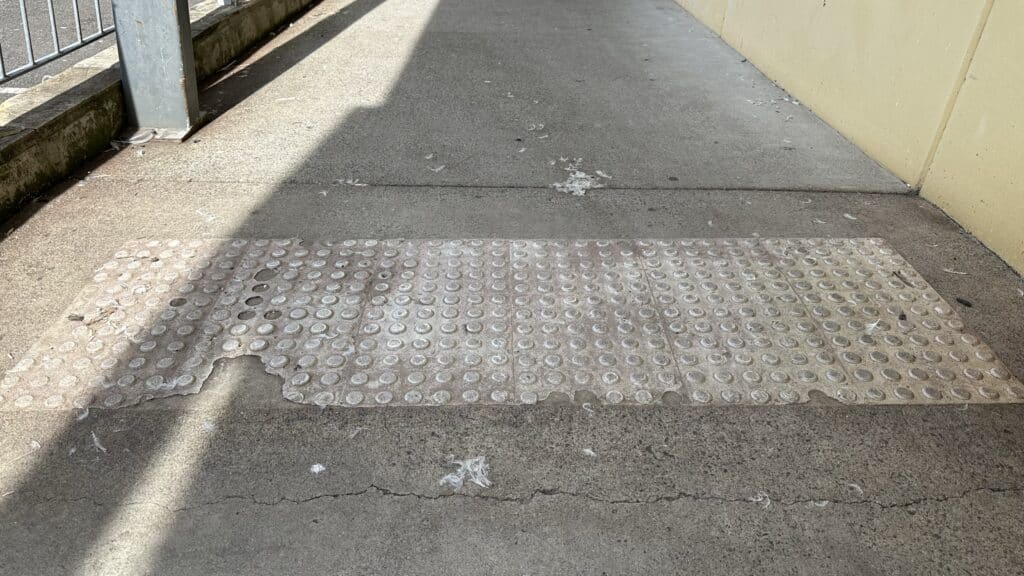
Maintaining Tactile Ground Surface Indicators (TGSIs) is crucial for several reasons, some of which we’ve outlined below.
- Safety for people with Visually Impairment: TGSIs are primarily designed to assist individuals with vision impairment in navigating spaces safely. They provide tactile feedback through different surface textures, alerting users to hazards such as road crossings, train platform edges, or changes in elevation. Regular maintenance ensures these indicators remain effective in signaling dangers.
- Compliance with Accessibility Standards: AS1428.4.1 provides the minimum requirements for TGSIs and are required by the National Construction Codes (NCC). Proper maintenance of TGSIs ensures compliance requirements continue to comply with these requirements. Neglecting their upkeep could lead to legal ramifications for property owners or managers.
- Durability and Longevity: Like any infrastructure component, TGSIs are subject to wear and tear. Environmental factors like weather, heavy foot traffic, and pollution can degrade their tactile properties over time. Regular maintenance, such as cleaning, repairing, or replacing worn-out sections, extends their useful life and ensures continuous functionality.
- Aesthetic Considerations: Well-maintained TGSIs contribute to the overall aesthetics of spaces. Neglected, damaged, or dirty indicators can detract from the visual appeal of an area and may convey a lack of care or consideration for accessibility needs.
- Enhancing Public Awareness: Regular maintenance of TGSIs also serves an educational purpose. It highlights the importance of such features for accessibility, raising public awareness about the needs of individuals with vision impairments and the role of TGSIs in meeting those needs.
- Cost-Effectiveness: Proactive maintenance can be more cost-effective in the long run. Addressing minor wear and tear promptly can prevent more significant, costly repairs or replacements in the future.
- Adaptation to Changing Environments: Spaces are constantly evolving with new construction, renovations, and changes in pedestrian traffic patterns. Regular maintenance of TGSIs ensures they are adapted to these changes and continue to serve their purpose effectively.
- Ensuring Uniformity and Consistency: TGSIs must be consistent in design and placement to be effectively used by individuals with vision impairments. Maintenance checks can ensure that these indicators are uniform across different locations, reducing confusion and enhancing usability.
- Liability Reduction: Proper maintenance of TGSIs can reduce the risk of accidents, thereby decreasing potential liability for property owners. Incidents where individuals are injured due to poorly maintained or absent TGSIs can lead to legal action.
- Social Responsibility and Inclusivity: Maintaining TGSIs reflects a commitment to social responsibility and inclusivity. It demonstrates a recognition of the diversity of the community and a commitment to ensuring that public spaces are accessible to all members of the community.
In conclusion, the maintenance of TGSIs is not just a matter of regulatory compliance; it is a multifaceted responsibility that encompasses safety, accessibility, aesthetics, cost-effectiveness, and social inclusivity.
Regular checks, cleaning, repairs, and updates are essential to ensure that these vital navigational aids continue to serve their purpose effectively and efficiently.
To have TGSIs inspected and the conditions reported please feel free to contact us.
Get In touch
Send an email or Call 1300 276 222
Key Services
Desktop Access Audits provide a comprehensive report and we work along side governments, design teams, owners, companies etc. to ensure disability access is provided and compliance is achieved.
Onsite Access Audits provide a comprehensive report and we work along side governments, design teams, owners, companies etc. to ensure disability access is provided and compliance is achieved.
A performance solution report is where a deemed to satisfy provision is not met and an alternative building solution is proposed. The performance solution report is to articulate how the building solution is equal to or greater than that of the minimum requirement.
More and more requests are being made of product suppliers to provide a disability access compliance certification. ASN specialises in these certifications for suitability and usability of mainstream products for people with disability.
A luminance contrast test is a calculation between two (2) surfaces Light Reflectance Values (LRV’s). This determines the percentage of difference and is used to confirm compliance or deem not compliant.
